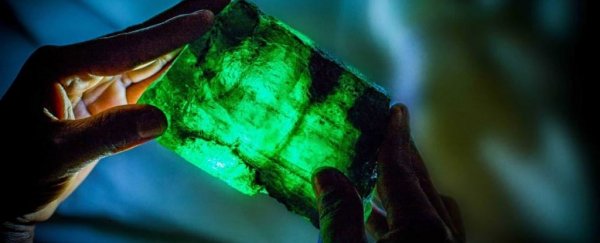From deep in the guts of the Earth, a rare treasure has emerged: one of the largest single emeralds ever found.
Hailing from the Kagem emerald mine in Zambia, it's been named Inkalamu, a Chibemba word that means "Lion Emerald". The beautiful stone weighs a whopping 5,655 carats (1,131 grams, or 39.9 ounces).
According to Gemfields, the company which owns 75 percent of the mine, the stone has "remarkable clarity and a perfectly balanced golden green hue."
Geologist Debapriya Rakshit and emerald miner Richard Kapeta discovered the emerald on October 2, in the depths of Kagem's largest open-pit mine. Although this particular pit has proven productive, Gemfields said, it had previously yielded nothing on the scale of Inkalamu.
Even so, the massive rock isn't the largest ever seen in the world, or even from the Kagem mine. That's a stone called Insofu (Chibemba for "elephant"), found in 2010, which came in at 6,225 carats.
The largest emerald ever gouged from the Earth is the Bahia emerald, from Brazil. It consists of a chunk of rock, with several large uncut emerald crystals embedded in it, weighing a total of 341 kilograms (752 pounds), or around 1.7 million carats. Of that weight, over 180,000 carats is estimated to be emeralds.
But Inkalamu is definitely up there, possibly even in the top 5.
 (Gemfields)
(Gemfields)
Emerald crystals are formed deep underground, in conditions where the crystals can often grow quite large.
However, inclusions - other material that becomes trapped in the crystals as they are forming - are relatively common, which means emerald crystals can be quite brittle, and don't always stay intact.
In Kagem, they are formed from beryllium that would have been carried into the Zambian metamorphic talc-magnetite schist with volcanic magma around 500 million years ago.
As the magma cooled, it formed a type of igneous rock called pegmatite, which left out the beryllium in the remaining fluid.
In the hot, high-pressure environment , this beryllium crystallised, tinted deep green by chromium in the talc-magnetite schist, gradually forming emeralds. Before its discovery, Inkalamu had been in the ground for roughly 450 million years.
Gemfields is going to auction the stone in Singapore in November, and it's expected that it may be cut into smaller stones after that, which will collectively be called the Pride of Inkalamu.
"There might be hundreds of offcuts that are fashioned into smaller gems, cabochons and beads, but the key lies in recovering the fine quality pieces," Gemfields' spokesman Adrian Banks explained in a statement.
"Given this emerald is such a rare find, it is also perfectly conceivable that the buyer will choose to purchase it as an investment."
Gemfields has promised that 10 percent of the auction's proceeds will be divided between two lion conservation programmes, the Zambian Carnivore Programme and the Niassa Carnivore Project.
